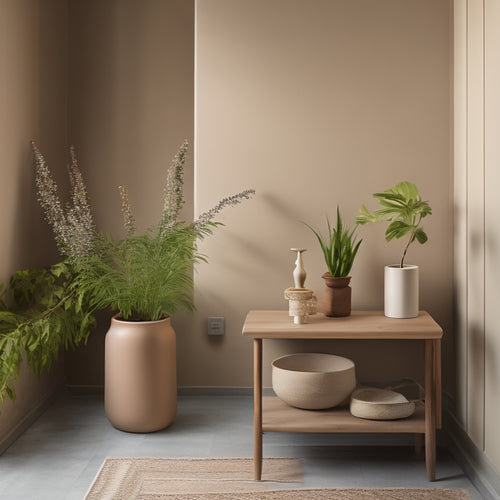
Non-Toxic Finishes for Healthier Earth-Conscious Home Furnishings
Share
By opting for non-toxic finishes for your home furnishings, you're not only shielding your loved ones from harsh chemical emissions, but also embracing a healthier planet by reducing the demand for synthetic materials and processes. You can choose from natural oil-based finishes that showcase wood grain beauty, water-based polyurethane options that guarantee durability, or plant-derived stains and dyes that bring vibrancy to your space. Alternatively, investigate low-VOC lacquer and eco-friendly wax coatings for a high-gloss sheen without the risks. As you initiate this earth-conscious expedition, you'll uncover a wealth of sustainable solutions that align with your values and cultivate a healthier living space.
Key Takeaways
- Natural oil-based finishes, like tung and linseed oil, create a protective barrier that's gentle on the environment and promotes a healthier planet.
- Water-based polyurethane options offer durability and low VOC formulas, aligning with the growing demand for sustainable living and healthier indoor air quality.
- Plant-derived stains and non-toxic dyes provide a range of colors from natural pigments, enhancing wood furnishings and fabrics while promoting eco-friendly values.
- Low-VOC lacquer and eco-friendly wax coatings offer high-gloss sheens without harsh chemicals, reducing carbon footprint and enhancing indoor safety.
- Sustainable sealants for fabrics, like plant-based wax coatings and natural oils, protect eco-friendly dyes and upholstery from wear, ensuring longevity and fabric integrity.
Natural Oil-Based Finishes Explained
Immerse yourself in the universe of natural oil-based finishes, and you'll uncover a domain of eco-friendly options that not only pamper your furniture but also the planet.
These finishes utilize the power of natural oils, such as tung oil, linseed oil, and hemp oil, to create a protective barrier that's gentle on the environment.
In addition, integrating renewable energy solutions, such as solar panels, into your home can further reduce your carbon footprint.
You'll reap the natural oil benefits, including a soft, subtle sheen and enhanced wood grain visibility.
Mastering application techniques is key: apply thin coats, allowing each layer to dry before adding the next, and use a clean cloth to wipe away excess oil.
With patience and practice, you'll achieve a stunning, non-toxic finish that not only beautifies your space but also supports a healthier planet.
Water-Based Polyurethane Options
In the domain of eco-friendly finishes, water-based polyurethane options emerge as a versatile and environmentally responsible choice for your home furnishings.
You'll appreciate the water-based durability these finishes offer, ensuring your pieces remain protected and beautiful for years to come. As governments increasingly incentivize sustainable transportation initiatives and renewable energy solutions, it's important to reflect on the environmental impact of our daily choices, including the finishes we use in our homes.
With the growing demand for sustainable living, water-based polyurethane options aren't only better for the planet, but also require eco-friendly maintenance that's easy on you and the environment.
With a low VOC (volatile organic compound) formula, these finishes promote healthier indoor air quality, making them perfect for homes, offices, and public spaces.
Plant-Derived Stains for Wood
Nature's palette is at your fingertips with plant-derived stains for wood, offering a lively range of colors and shades that not only enhance the beauty of your wood furnishings but also align with your eco-friendly values.
You can choose from a variety of plant-based pigments, extracted from sources like turmeric, indigo, and pomegranate, to create unique and lively hues.
Optimize your wood finishing process by considering the energy-efficient equipment used in solar EV charging stations, and guarantee a sustainable approach.
These stains are free from harsh chemicals, making them a healthier choice for you and the environment.
With eco-friendly application methods, you can guarantee a safe and sustainable finishing process.
Low-VOC Lacquer Alternatives
You're likely familiar with the high-gloss sheen of traditional lacquer, but you may not know that it comes with a hefty price: harsh chemicals and strong fumes.
Fortunately, eco-friendly lacquer options are emerging, offering a safer, healthier alternative. As the world shifts towards sustainable energy consumption, integrating solar power integration in various industries can have a significant impact.
Eco-Friendly Lacquer Options
Sustainability converges with style as eco-friendly lacquer options emerge as a viable alternative to traditional, chemical-laden finishes. You can now choose from a range of eco-friendly varnishes that not only look great but also promote a healthier environment.
With the increasing adoption of renewable energy sources for EV charging, such as solar-powered fast charging, the demand for sustainable living solutions is on the rise.
These innovative finishes are made from natural ingredients, are biodegradable, and have low to no VOCs (volatile organic compounds). By opting for eco-friendly lacquer options, you're reducing your carbon footprint and creating a safer space for you and your loved ones.
This shift towards sustainable living is a significant step towards a healthier earth-conscious home. As you investigate these alternatives, you'll uncover a world of possibilities that merge style with environmental responsibility.
Water-Based Finishes Explained
As you investigate deeper into the world of eco-friendly lacquer options, water-based finishes emerge as a prime contender for low-VOC lacquer alternatives. These finishes are made with water as the solvent, reducing the amount of harmful chemicals released into the environment. This sustainable sourcing approach not only benefits the planet but also guarantees a healthier living space for you and your family.
| Water-Based Finish | Eco-Friendly Certification | VOC Level |
|---|---|---|
| Water-based polyurethane | Greenguard Gold | < 150 g/L |
| Plant-based wax finish | Eco-Institut certified | < 100 g/L |
| Natural oil finish | Oeko-Tex Standard 100 | < 50 g/L |
| Water-based stain | California Air Resources Board (CARB) compliant | < 200 g/L |
| Low-VOC acrylic finish | LEED compliant | < 250 g/L |
Safer Solvent Choices
When opting for eco-friendly lacquer alternatives, it's crucial to scrutinize the solvents used in their composition.
You want to verify they're free from harsh chemicals that can harm your health and the environment. Look for natural solvents derived from plants, such as turpentine or citrus-based solvents.
These alternatives aren't only safer but also more sustainable. Opt for brands that prioritize sustainable sourcing, reducing their carbon footprint, and promoting environmentally responsible practices.
Eco-Friendly Wax Coatings
Uncover the world of eco-friendly wax coatings, a natural and non-toxic way to protect and enhance your home furnishings.
You can choose from a variety of waxes that not only safeguard your furniture from wear and tear but also promote a healthier living space.
Beeswax, for instance, is a popular choice due to its numerous benefits, including being a natural waterproofing agent and having antibacterial properties.
Carnauba wax, derived from palm trees, is another eco-friendly option that adds a layer of protection while maintaining the natural appearance of your furniture.
Non-Toxic Dyes for Upholstery
Beyond wax coatings, you're likely enthusiastic to investigate non-toxic alternatives for upholstery, and that's where eco-friendly dyes come in.
You want to guarantee the fabrics in your home aren't only stylish but also safe for you and the environment. Plant-based pigments and non-toxic colorants are the answer.
These innovative dyes are derived from natural sources like fruits, vegetables, and spices, offering a healthier alternative to synthetic dyes. By choosing eco-friendly dyes, you're reducing your carbon footprint and promoting a more sustainable lifestyle.
Imagine lounging on a sofa upholstered with fabric dyed from pomegranate or turmeric – not only is it a lively conversation starter, but it's also a conscious choice for a healthier home.
Sustainable Sealants for Fabrics
You've got your eco-friendly dyes, but what about protecting those lively hues and the fabric itself from wear and tear?
Sustainable sealants for fabrics are an essential step in creating eco-friendly upholstery that not only looks great but also stands the test of time.
When choosing a sealant, consider these eco-friendly options:
- Plant-based wax coatings that repel water and stains
- Natural oils like linseed or tung oil that nourish and protect the fabric
- Beeswax-based finishes that add a layer of protection without harsh chemicals
- Soy-based treatments that strengthen fabric fibers and resist wear
These sustainable fabric treatments guarantee your upholstery remains bright, durable, and healthy for years to come, aligning with your values of freedom and environmental responsibility.
Frequently Asked Questions
Can I Use Non-Toxic Finishes on Antique Furniture?
When you're considering antique restoration, you can definitely opt for non-toxic finishes, which not only preserve the piece's integrity but also provide health benefits for you and your family, while aligning with your values of freedom and eco-friendliness.
Are Eco-Friendly Finishes More Expensive Than Traditional Options?
You're wondering if eco-friendly finishes break the bank? While they might be pricier upfront, you'll find that cost comparison shows they're often on par with traditional options, and market trends suggest they'll save you money in the long run.
Can I Mix and Match Different Non-Toxic Finishes?
As you venture into the world of eco-friendly finishes, you're wondering if you can mix and match different non-toxic options. You'll be relieved to know that, yes, you can, but it's vital to guarantee non-toxic compatibility when layering finishes to avoid unwanted chemical reactions.
Do Non-Toxic Finishes Provide the Same Durability as Traditional Options?
When choosing eco-friendly finishes, you're probably wondering if they'll hold up as well as traditional options. The good news is that many non-toxic finishes offer similar long-term performance, while also reducing environmental impact, giving you a clear conscience and a healthier home.
Can I Apply Non-Toxic Finishes to Previously Finished Furniture?
As it happens, you're considering refinishing that vintage find, and you're wondering if you can apply non-toxic finishes to previously finished furniture. Yes, you can! Proper furniture preparation and application techniques are key to a successful, eco-friendly makeover.
Related Posts
-

3 Best Eco-Grants for Home Energy Upgrades
You're eligible for various eco-grants that can help you cut down on energy bills and reduce your carbon footprint by...
-

What Are Natural Clay Paints for Green Home Interiors?
You're about to uncover a game-changing alternative to synthetic paints that not only enhances the aesthetic of your ...
-

10 Powerful Electric Mowers for Expansive Lawns
You're moving away from gas-powered mowers and exploring electric options for your expansive lawn. You'll find that h...


